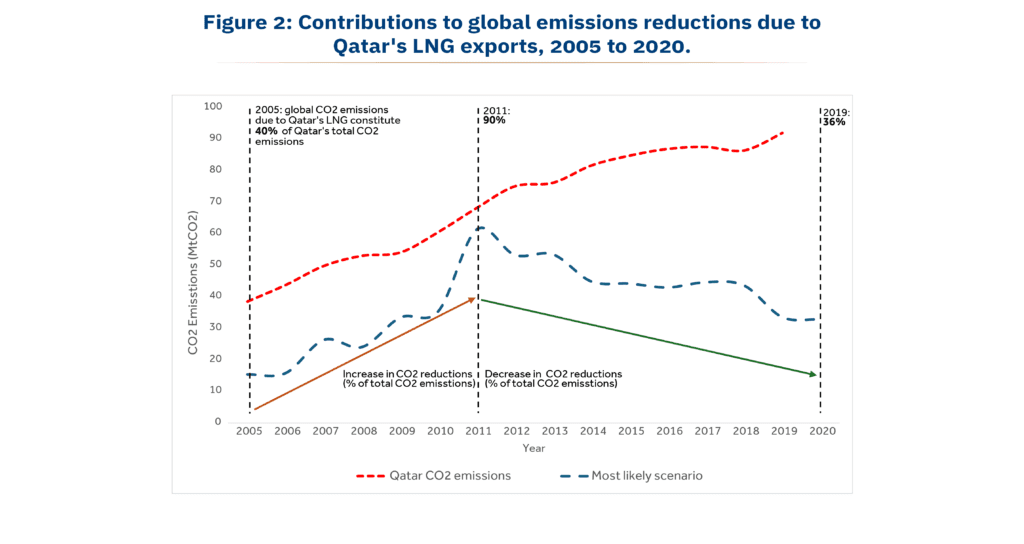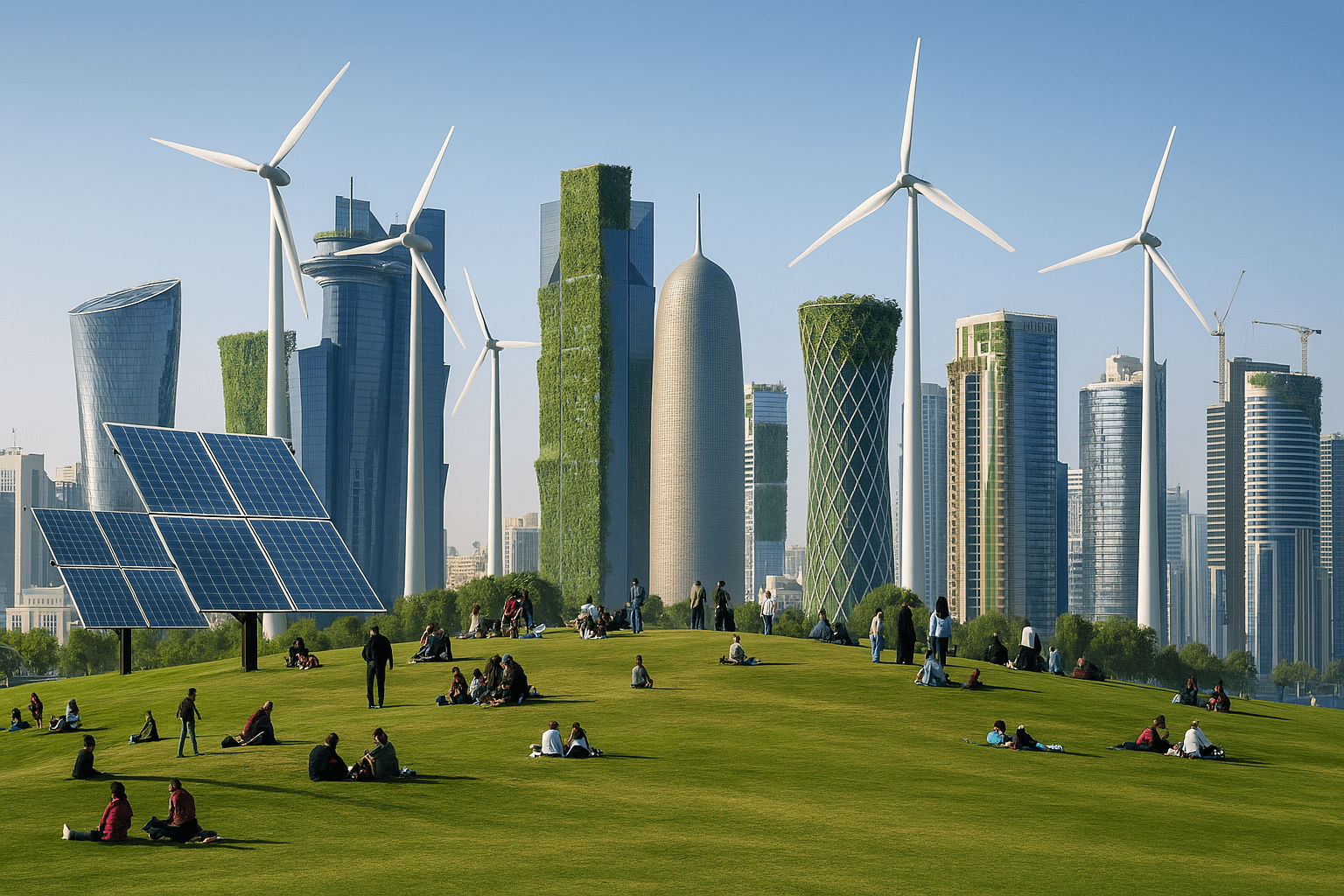
Offsetting Emissions Through LNG Exports: Past and Future Trends
March 2025
Introduction
Over the past two decades, natural gas has increasingly been adopted as a substitute for more carbon-intensive fuels. This, coupled with lower prices, technological development, and infrastructure expansion, has led to increased demand for natural gas, including liquified natural gas (LNG). These fuels are therefore expected to play a major role in the future of global energy systems. While some studies have indicated potential negative effects of increased use of natural gas, most of the evidence suggests that LNG produces lower greenhouse gas (GHG) emissions per unit of energy than other fossil fuels, such as coal and other heavy hydrocarbons.1
As a major exporter of LNG, Qatar has benefited from this global rise in demand, experiencing a 10-fold increase in GDP between 2000 and 2020.2 Most of Qatar’s LNG is exported to Asia, mainly South Korea, Japan and China, where it is primarily used in industry and power generation.3
This paper presents the findings of a research exercise that estimated the reductions in carbon dioxide (CO2) emissions resulting from the use of Qatari LNG as a replacement for more carbon-intensive fuels in Qatar’s export markets. The findings show that Qatar’s LNG exports likely offset global emissions by 600 Metric tons of CO2 (MtCO2) between 2005 and 2020, equivalent to 40% of Qatar’s domestic emissions during the same period. Yet while this demonstrates the historical contribution of Qatar’s LNG to global decarbonization, the future may look different. The global shift away from coal in the power and industrial sectors may reduce the degree to which LNG can offset emissions. However, Qatar can continue to contribute to global decarbonization efforts in several other ways.
Qatar’s Commitments
In 2019, Qatar’s total annual CO2 emissions were 92 MtCO2 and total GHG emissions (solid red line in Figure 1, Panel A) were 115 MtCO2 equivalent (MtCO2e). Between 2005 and 2019, Qatar’s CO2 and GHG emissions doubled, with an average year-on-year growth of 6.5% and 6.3%, respectively. A large percentage of Qatar’s total GHG emissions are fugitive (unintended) emissions from the LNG production process. However, between 2005 to 2019, Qatar’s non-CO2 GHG emissions as a percentage of the total decreased from 22.5% to 19.9%, owing to efficiency gains and in line with state energy firm QatarEnergy’s commitments to reduce emissions during the LNG production process.
In 2023, Qatar launched its National Climate Change Action Plan (NCCAP), which targets a 25% reduction in GHG emissions by 2030. In addition, QatarEnergy recently upgraded its sustainability strategy, strengthening its commitment to delivering cleaner LNG. The strategy outlines numerous initiatives to reduce GHG emissions, including deployment of carbon capture technology to capture over 11 MtCO2 per year by 2035.4 QatarEnergy also committed to driving the energy transition by expanding its LNG production capacity to 126 Mt per annum by 2027,5 and in early 2024 announced plans of further increases in LNG production to 142 Mt by 2030.6 The company is focused on achieving zero routine flaring by 2030, through investment in innovative technologies and maintenance procedures.
Over 90% of GHG emissions in Qatar are attributed to energy use (primarily for climate control in buildings due to the extremely hot climate) and the hydrocarbon sector. Reductions in GHG emissions in the LNG supply chain in Qatar will have a significant impact on the country’s overall emissions. Some estimates indicate that LNG production accounts for almost half of the total.7
Qatar’s Contribution to Global Decarbonization
Qatari LNG can be assumed to have replaced more carbon-intensive fossil fuels its export customers would otherwise have used, such as coal and oil. Using historical data, this section presents past scenarios in order to estimate the reduction in global GHG emissions that may be attributed to the increased use of LNG. It models a scenario under which Qatar’s LNG disappears from the global fuel mix between 2005 and 2020, in order to estimate the contribution of Qatar’s LNG exports to reductions in global CO2 emissions. It then asks how these exports might contribute to future reductions in those emissions, if any.
Several scenarios are considered. In the first, Qatar’s LNG is replaced by coal, which represents the highest possible variation from actual emissions (Upper Bound, Figure 1, Panel B), due to coal’s much higher carbon intensity compared with LNG. In another, Qatar’s LNG is replaced by other fuels in proportion to their existing share in the energy mix, reflecting the lowest possible reduction in emissions attributable to Qatar’s LNG exports (Lower Bound, Figure 1, Panel B). This scenario, based on the actual energy mix in Qatar’s LNG export markets, assumes the most efficient allocation of the different energy sources to satisfy demand. Another scenario, under which Qatar’s LNG would be replaced with LNG from other exporters, would require a 75% annual increase in production by other exporting countries. Therefore, this scenario is not considered here.

Figure 1. Results of historical analysis: (a) Total reductions in global CO2 emissions attributable to Qatar’s LNG exports if coal had been used instead; (b) total reductions in global CO2 emissions by Qatar’s LNG exports compared to the use of coal (dark blue line) or proportional use of the existing energy mix (light blue line); (c) the identified Upper and Lower Bounds of global CO2 emission reductions due to Qatar’s LNG exports; (d) the range of likely global CO2 emission reductions due to Qatar’s LNG exports replacing coal and other fuels.
The “most likely” scenario is inferred from the Upper and Lower Bounds. Under this scenario, whether coal replaces Qatari LNG (Scenario 1) or all fuels do so proportionally (Scenario 2) depends on the share of coal in the energy mix and the increase in coal usage relative to the growth of total consumption. As a result, the most likely reduction in global CO2 emissions due to Qatar’s LNG exports lies somewhere between the Upper and Lower Bounds. Figure 2 shows the reduction in CO2 emissions under this scenario (dotted blue line) relative to Qatar’s domestic CO2 emissions.

Figure 2. Contributions to global emissions reductions due to Qatar’s LNG exports, 2005 to 2020.
Under this scenario, global CO2 reductions due to Qatar’s LNG exports are equivalent to 40% of Qatar’s local CO2 emissions in 2005 (Figure 2), peaking at 90% in 2011, when both the share of coal in the energy mix in export markets and the growth rate of coal consumption were high. Reductions in CO2 emissions then decrease gradually after 2011. Consequently, by 2019, the reduction in global CO2 emissions attributed to Qatar’s LNG exports would be equivalent to 36% of local annual emissions. Between 2005 and 2020, this scenario predicts a cumulative reduction in global CO2 emissions due to Qatar’s LNG exports amounting to 605 MtCO2.
Between 2005 and 2011, the increase in reductions can be attributed to increases in coal consumption globally, meaning more hypothetical coal usage was instead offset by Qatar’s LNG exports. After 2011, the decrease in reductions, whether absolute or relative to local emissions, can be attributed to two factors: a fall in global coal consumption – and therefore less coal to be replaced – and an increase in local CO2 emissions in Qatar.
Policy Implications
Based on the “most likely” scenario, such reductions beyond 2020 are likely to decrease through to 2040. Assuming a business-as-usual scenario for Qatar’s local emissions between 2020 and 2040, reductions in global CO2 emissions as a percentage of local emissions decreases faster than for the period between 2011 and 2020. This is primarily due to a consistent decline in global coal consumption, amounting on average to 5.2% annually between 2020 and 2040. Lower coal consumption globally means that Qatar’s LNG exports are more likely to be replacing less carbon-intensive fuels and technologies. Leading up to 2040, given the increase in the adoption of renewable energy globally, Qatar’s LNG exports are likely to increase, rather than decrease, global CO2 emissions.
Consequently, to ensure that Qatar continues to contribute to reductions in global CO2 emissions while offsetting its domestic emissions, several options may be considered. First, it is important to prioritize local emission reductions through energy efficiency measures that increase buildings’ energy efficiency, and by raising public awareness about efficient energy use. Second, Qatar can target the transport sector, through fossil fuel subsidy reforms and promotion of electric vehicles. Third, the government could institute import regulations on energy-intensive goods and services, and adopt circular economy principles across multiple sectors, to incentivize sustainable production and consumption.
A more targeted export strategy that ensures that Qatar’s LNG continues to displace coal and other carbon-intensive fuels in its export markets could also help ensure LNG contributes positively to global decarbonization efforts. Exporting to countries with a high share of coal and other carbon-intensive fuels in their energy mix would maximize the net impact of LNG in reducing global GHG emissions. In addition, diversifying Qatar’s energy services portfolio to include renewable energy in previously untapped markets could contribute to green growth abroad.
Many developing countries need, and can accommodate, decentralized energy solutions. Unlike hydrocarbons, renewable energy is not heavily dependent on one specific type of infrastructure. While most developing countries lack the financial capacity to expand existing grids to increase the supply of electricity, Qatar is in a unique position to support the expansion of energy access.
Finally, exploring new markets where Qatari LNG could replace more carbon-intensive fossil fuels would simultaneously open up commercial opportunities. Many developing countries, especially in Sub-Saharan Africa, do not possess the necessary infrastructure to import LNG. For example, in 2021 Ghana was the first country in Sub-Saharan Africa – and second on the entire continent, after Egypt in 2015 – to start importing LNG.8 Developing countries will continue to rely on their existing infrastructure, which was designed around, and continues to cater to, more carbon-intensive fossil fuels. For example, many of the countries in Southern Africa rely on coal imports from South Africa. Developing LNG infrastructure in a select number of developing countries could increase demand for LNG while simultaneously reduce reliance on more carbon-intensive fossil fuels.
Conclusion
The substitution of coal and other carbon-intensive fuels by Qatar’s LNG exports has historically contributed to reductions in global CO2 emissions. Between 2005 and 2020, these cuts amounted to around 605 MtCO2, the equivalent to more than three years’ worth of emissions in a middle-income country such as Peru. However, such reductions peaked when coal demand was highest in 2011 and have since declined. This decline is likely to continue until 2040, as the world moves away from coal and other hydrocarbons towards cleaner fuels and technologies. It is, therefore, unlikely that global reductions in emissions due to Qatar’s LNG exports will increase again.
To ensure that Qatar’s contributions to global carbon reduction efforts continue into the future, there are several pathways to consider. First, local emissions could be reduced through energy efficiency measures, fossil fuel subsidy reforms, and the adoption of circular economy principles. Second, an export strategy that targets countries with a high share of coal in their energy mix could ensure that LNG contributes positively to global decarbonization efforts. Third, investing in energy infrastructure in new export markets with future growth prospects, particularly in energy-poor Sub-Saharan African countries, could support a transition away from carbon-intensive fuels and increase access to energy for vulnerable populations.





